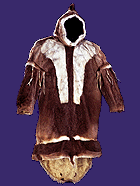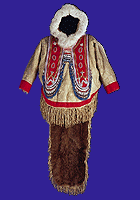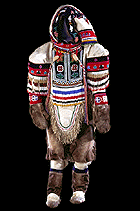
![]()
Inuit Parkas
 |
Man's outer parka; Copper Inuit; collected by Diamond Jenness, Coppermine River, Northwest Territories, 1914-1916; caribou skin, sinew; 120 cm. long, 68 cm. wide. CMC IV-D-918 The Inuit of Canada's Arctic live in one of the most extreme climates in the world. Clothing has been one of the keys to their survival. In addition to physical protection, clothing has also visually communicated information about who they are as a people. Traditional Inuit clothing consisted of a parka, pants and mittens made from caribou or sealskin (worn in one or two layers according to the season), and up to four layers of footwear. Each garment was tailored to fit the individual. The seamstress, relying on years of experience to determine the shapes and sizes of pattern pieces, used hand, string and eye to measure, or used already existing garments as models. |

|
Man's inner parka; Southern Caribou Inuit (Paatlirmiut or Ahiarmiut); Nueltin Lake, Northwest Territories, before 1924; caribou skin, glass beads, stroud, moose teeth, brass shell case, cotton thread. CMC IV-C-2664 As early as 1718, Caribou Inuit were trading with Hudson's Bay Company ships that travelled along the west coast of Hudson Bay. Coloured cloth, glass beads and metal added a new dimension to personal adornment and clothing decoration that conferred prestige upon the wearer. Caribou Inuit men's inner parkas were decorated with beadwork in geometric compositions. Although beads were placed in areas that followed traditional clothing decoration, the designs gave the seamstress an outlet for her creative flair. CMC IV-C-2664 "The men are almost as fond of beads as the women, and a long-tailed deerskin coat covered with beads excites admiration and envy."
David Hanbury, Sport and Travel in the Northland of Canada, London: Edward Arnold, 1904 |
 |
Woman's beaded parka; made by Lizzie Ittinuar, Rankin Inlet, Northwest Territories, 1975; caribou skin, glass beads, cloth, cotton thread, wool yarn, wood; 159 cm. long, 79 cm. wide. CMC IV-C-4538 The chest panel on the parka made by Lizzie Ittinuar was originally part of a parka made in 1935 for Winnie Crawford by Hattie Niviaqsarjuk, originally from Baker Lake, Northwest Territories. Lizzie Ittinuar's first sewing project as a teenager was a pair of small boots. "We still follow our grandmothers, and their grandmothers. It's the way we pass it on. It's the traditional way of doing it. We are following the traditions of our ancestors."
Lizzie Ittinuar, 1992 |

